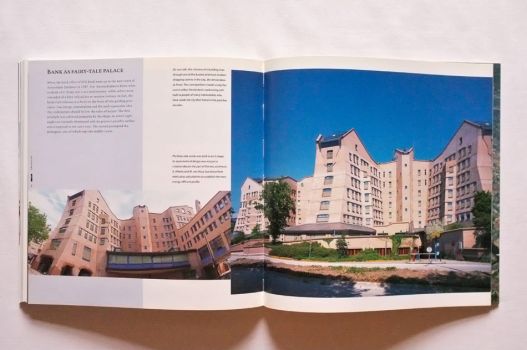Amsterdam
Portrait of a City
£9.95
With more than 150 photographs, this guide provides both a literal and figurative portrait of Amsterdam. The pictures show the sights. The text paints in the background and captures the spirit of the city. Use the book as a preview and, when you have decided what to see, turn to the Trip Planner on the inside covers to find out how to get there.
Dispatched next day with Royal Mail 2nd Class
- RRP: £9.95
- Format: 220 mm x 220 mm (8 2/3 x 8 2/3 in)
- Pages: 96
- Weight: 0.4 kg (0.9 lb)
- Pictures: 150 colour
- Binding: Paperback with gatefolds
- ISBN: 978 1 873329 29 0
- Publication: 1998
Rummaging around in the Waterlooplein flea market, you can find an unexpected side of Amsterdam, a souvenir of another city half-hidden in the interstices between history and tourism and screened by the famous 17th-century façades of gabled canal-side houses. You may catch glimpses of it, too, along the battle-scarred route of the Metro where demonstrators fought developers in the 1970s, and on the moving canvas of trams leased out to artists by a playful city council. This is the city that Jan den Hengst and Jacques Constant have captured in a wide-screen preview: a living community with its own alternative lifestyles. Amsterdam is very much a contemporary portrait. All 150 photographs have been specially taken for the book, many of them panoramics stretching across two pages. They show not just the Rembrandts and the Vermeers of the Rijskmuseum, Van Gogh’s sunflowers, the church spires and gun towers, the brown cafés darkened with age and the polychrome excesses of the Gothic Revival, though all of these are here, but also the achievements of the Amsterdam School and the most inventive modern buildings, including the new glass and steel Sloterdijk station. It is a fresh, invigorating and informative insider’s view of one of Europe’s most popular holiday destinations.
When you have decided what you would like to see, you can find out how to get there, where to stay, eat, drink or be entertained by turning to the Trip Planner on the inside covers. Here you will find all the practical information you need to plan a visit to Amsterdam, organized under convenient headings with a comprehensive index.
Central Station
Exchange and Finance
Dam and Palace
From Post Office to Shopping Centre
The Smell of Tar and Ropes
Montelbaanstoren and Surrounds
Life in the 17th Century
Housing in the ’Twenties
Life After the ’Eighties
Living On and Near Water
The University of Amsterdam
Hotels on Historic Sites
A Sea of Flowers
The Magere Brug Area
Art and Administration Under One Roof
Rummaging in the Waterlooplein Market
Jewish History Museum
Anne Frank House
Renzo Piano’s ‘Shipwreck’
Sail Amsterdam
Nature in Miniature
The Piety of the Merchant
The Oasis of the Pious Women
History of a City
Eating and Drinking
Temple to Lady Fortune
Musical Extremes
The Rijksmuseum
The Past for Sale
Advertising from Centuries Ago
Markets of Amsterdam
Vincent van Gogh in Amsterdam
Modern Art Behind Old Walls
Amsterdam and Water
Public Transport
Bank as Fairy-Tale Palace
Spaceship for Ajax Amsterdam
Schiphol
Jan den Hengst, born in 1934, went to horticultural college in Boskoop and later emigrated to Zimbabwe, then called Rhodesia. There he got into arable farming and landscape architecture. He returned to Europe in the 1960s and took up photography in Cologne. He has been working as a freelancer ever since. As well as providing photography for several publications, Hengst has written and illustrated his own book, The Dodo, the Bird That Drew the Short Straw.
Jacques Constant started his career as a newspaper and magazine journalist in Holland and the Dutch West Indies. He now devotes most of his time to writing and editing books. He has had work published under the names Jac G. Constant and Jacques G. Constant.

LIVING ON AND NEAR WATER
In the distant past, travellers from abroad compared Amsterdam to Venice, in part because it was a centre of foreign trade, but primarily because it was dissected in every direction by canals. Even now, many Amsterdammers live on or next to the water. Canal-side houses are among the most expensive in the city. Houseboats are moored stem to stern, sometimes in double rows, on almost every canal. Some are hardly different, in terms of comfort or price, from the houses they look out on. Unlike Venice, however, Amsterdam is not restricted to water traffic. Even if the canals freeze over – which does happen in harsh winters – it causes few problems. The city council simply closes off a large number of canals to round-trip boats and other shipping and gives Amsterdammers a chance to cross the city on skates.
A SEA OF FLOWERS
The Netherlands has been famous for its flowers ever since the tulip mania of the early 17th century, when fortunes were made and lost as speculators bid up the price of the rarest bulbs to unsustainable peaks. Later, the growing of tulips, hyacinths and other blooms which flourish in the sandy soils around Haarlem settled down and became a serious industry. Today the country is the largest flower exporter in the world. There are even plans to build a tunnel between Amsterdam airport and the huge flower auction at Aalsmeer to make the exporting of flowers easier. In Amsterdam, the main place to find flowers is the famous flower market on the Singel, behind the Munttoren. Even in winter, the market is a sea of cut flowers and flowering plants. Some overflow into the street, others can be found in covered stalls on boats in the canal. The market on the Singel is not the only flower market in the city, but it is the best known. Foreign visitors cluster to buy bulbs there as a memento of the vibrant colours with which the Amsterdammers like to brighten their northern skies.












